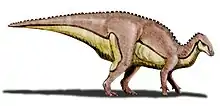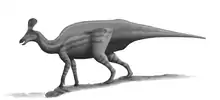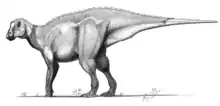Amblydactylus
Amblydactylus is an ichnogenus that has been attributed to dinosaurs. The generic name, derived from the Greek words amblys and dáktylos, means "dull finger". Two species of Amlydactylus have been named: A. gethingi, which references the Gething Formation where it was found; and A. kortmeyeri, which honours Carl Kortmeyer who discovered the holotype.
| Amblydactylus | |
|---|---|
| Trace fossil classification | |
| Kingdom: | Animalia |
| Phylum: | Chordata |
| Clade: | Dinosauria |
| Order: | †Ornithischia |
| Suborder: | †Ornithopoda |
| Ichnogenus: | †Amblydactylus Sternberg, 1932 |
| Type ichnospecies | |
| †Amblydactylus gethingi Sternberg, 1932 | |
| Ichnospecies[1] | |
Large dinosaur tracks in the Winton Formation of Queensland, Australia, at the Lark Quarry trackway, were previously identified as cf. Tyrannosauropus and were as such interpreted as belonging to a large theropod. However, Tyrannosauropus has since been declared a nomen dubium and the referred tracks likely belonged to hadrosaurid ornithopods. Similarly, the large Lark Quarry footprints are also now suggested to belong to an ornithopod, and are most similar to Amblydactylus gethingi, with the suggested referral of Amblydactylus cf. gethingi.[2][3]
See also
References
- "†Amblydactylus Sternberg 1932", Fossilworks, retrieved 2020-03-09
- "Australia's biggest carnivorous dinosaur forced to take a walk". UQ News. 16 December 2010.
- Romilio, Anthony; Salisbury, Steven W. (2011-04-01). "A reassessment of large theropod dinosaur tracks from the mid-Cretaceous (late Albian–Cenomanian) Winton Formation of Lark Quarry, central-western Queensland, Australia: A case for mistaken identity". Cretaceous Research. 32 (2): 135–142. doi:10.1016/j.cretres.2010.11.003. ISSN 0195-6671.





.jpg.webp)
